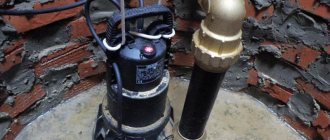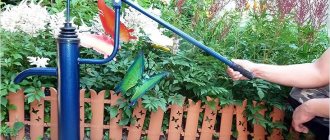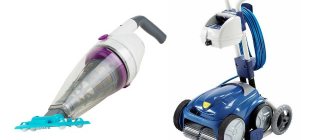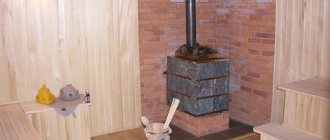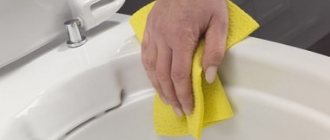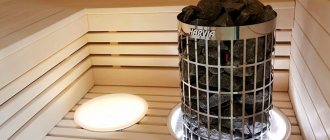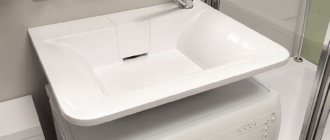25.01.2021
Septic tank
Editorial staff of the “New Place” website
Share
From this article you will learn
:
- Why do you need a drainage pump for a septic tank?
- Difference between fecal and sump pumps
- 10 options for choosing a drainage pump
- 5 Best Sump Pumps for Septic Tank
- 5 steps to install a sump pump
How to choose the best sump pump for a septic tank? And what should you look for first when purchasing this unit? There are a large number of nuances that should be taken into account, and you cannot do without certain knowledge.
Firstly, a lot depends on the type of device and the method of its installation, and secondly, the performance and ability to cope with solid fractions of a certain size in water. It is also necessary to take into account the possibility of autonomous operation and the presence of overheating protection. However, let's talk about everything in order.
Why do you need a drainage pump for a septic tank?
A modern septic tank is a system with several stages of purification. Bacteria process and decompose waste and effluent, ultimately turning it into purified water to a certain extent. In this case, the processed fractions settle at the bottom in the form of sludge.
In cases where groundwater in the yard is located close to the surface and the ground has a large percentage of clay, it will not be possible to drain processed and disinfected wastewater into the soil. You will need to pump it out using a sewer truck or using a drainage pump yourself.
It is clear that pumping out waste using vacuum trucks is easier - contact the service and wait. However, it is not always possible to use such services. There are hard-to-reach places where equipment simply cannot reach, and the cost of removing the contents of the septic tank increases as the hose lengthens. In such a case, you will have to use a drainage pump to pump wastewater into a special tank, which is located in a place convenient for the sewer truck.
This pump is suitable for removing liquid and sludge from a septic tank. According to the principle of operation, it is similar to an ordinary one, but has some nuances - the ability to work in an aggressive environment and with large waste.
A selection of the best models of drainage pumps for septic tanks will be presented below.
Types of pumping equipment for the kitchen
There are several types of devices, depending on the tasks performed. All models pump out wastewater, but in different cases it is more effective to use different types of equipment. They are divided into the following types:
- sanitary;
- stationary;
- pumping stations.
Sanitary models are considered the easiest to install; they have low power and in most cases are mounted under the sink. As a rule, they do not have chopping knives in their design. The temperature of the waste liquid cannot exceed 40 degrees; such models are capable of draining wastewater from only one unit of plumbing fixtures.
Connecting a washing machine and dishwasher will not work. The advantage of this type is its small size, ease of installation and dismantling, and low energy consumption. Such a sewage pump is often installed in small apartments.
The stationary version in most cases is connected to several devices at once and is installed away from all plumbing. Such devices are suitable for treating hot water (up to 75 degrees) and have greater power. As a rule, they are equipped with grinding elements.
Domestic sewerage stations have the greatest capacity. The maximum vertical movement is approximately 10 meters, horizontal movement can reach 100 m. Such models are rarely installed in apartments, most often they are installed in country dachas and cottages. Adapted to high water temperatures, can work continuously for a long time.
Difference between fecal and sump pumps
Drainage and sewage pumps are not the same thing. Probably, confusion when choosing a device arises due to the fact that both units are used for pumping out contaminated liquid. But there is an obvious and fundamental difference between them.
The main difference is that the fecal pump is designed for pumping water of varying degrees of viscosity, cloudy and oily, with fibrous inclusions, solid particles with a diameter of 40–80 mm. In some models of units, a grinder is installed to process large particles into a fine state.
The sump pump can remove liquids containing small solids such as sand or small pebbles. Their diameter should be no more than 5–10 mm.
The drainage pump is not intended for pumping sediment from the bottom and fecal matter. Its function is exclusively to pump out already filtered liquid from the storage well.
The best drainage pumps for septic tanks are models for pumping dirty water, equipped with a float switch that is activated when the water level in the tank exceeds a predetermined level.
How to choose the right power?
When choosing a pump of suitable power, you need to understand that the parameters specified in the instructions are the characteristics that the pump produces at the limit of its capabilities. In order for the toilet sewer pump to easily cope with its work, it is better to take the one that is more durable, providing a reserve of power.
It is worth understanding that if, conditionally, the pump moves wastewater 50 m horizontally and vertically, then if there are vertical sections in the real system where it has to work, its ability to push water horizontally will decrease. If some section of the pipe is vertical, then horizontally the toilet pump-shredder will easily push waste only 20-30m.
The fecal pump with grinder must be of a suitable power for you.
Installation
Self-installation of a drainage pump in a septic tank must be carried out in compliance with certain rules. For example, it is not allowed to install equipment intended for wells in septic tanks, and vice versa. Despite their external similarity, the models have different permissible power and operating principles.
It is also not recommended to work with budget options such as “Baby” or “Rucheek” and others - they cost pennies, but are characterized by poor build quality. After pumping out the entire volume of water, they do not turn off, unlike models such as Makita, Gardena, Alco, Grundfos or Profer.
What are they for?
The need to install this equipment in an apartment can be caused by several factors, namely the redevelopment of simple city apartments. Sometimes, to create a comfortable space, it is necessary to move the bathroom and toilet to the center of the apartment.
Sometimes the kitchen must be moved from one room to another , so that the dishwasher and sink are next to the sewer riser. In this case, the pipeline will have to be broken, and this is fraught with the formation of blockages.
In addition, a new route will have to be laid for the pipe , which may run through the hallway or room. This is unacceptable. Sewage pumps for apartments can successfully solve such problems.
Construction of houses
0 votes
+
Vote for!
—
Vote against!
The layout of bathrooms and plumbing fixtures in country houses and cottages is always fraught with the difficulty that they must be located close to the sewer riser. Also, the pipes leading to the riser must have a slope in its direction so that the wastewater can move by gravity. Such conventions impose certain restrictions - all plumbing fixtures should be located close to each other. This problem becomes irrelevant if sewage pumps are installed. Using these pumps allows you to install a toilet, washing machine, shower and other appliances where it is convenient for you, in the basement or basement - below the location of the main sewer pipe. This is especially true for cafes, restaurants and sports clubs located in the basements of high-rise buildings. Sometimes in country houses they install fecal submersible pumps that process wastewater from the entire house and pump it into a septic tank. Such pumps differ from those described above, and in order not to make a mistake, you need to understand what each pump is intended for.
- Types of sewage pumps
- Domestic sewage pumps
- Industrial sewage pumps
- Sewage pump installation
- Connecting the sewer pump to the toilet
- Connecting a sewer pump in the kitchen
- Installation of a sewage pump in a collection well
Types of sewage pumps
Sewage pumps can be divided into two categories: domestic and industrial. Domestic pumps are designed for pumping wastewater from one or more consumers and can be used in country houses, private small hotels, cafes, restaurants, bars, clubs and shops. Industrial sewage pumps are installed in multi-storey buildings or even in substations leading to the sewer.
Domestic sewage pumps
Sewage pumps for domestic needs differ in purpose and place where they are used, and also have design differences. For example, there are pumps that are installed directly under the water consumer, and there are pumps for forced sewerage that are installed in the well of a septic tank or sewage pumping station.
Household sewer pumps come in the following versions:
- Sewage pump for toilet (equipped with a grinder).
A pump of this type is installed directly behind the toilet no further than 40 cm and is a box approximately the size of a toilet flush cistern. The color of the pump body can be chosen so that it matches the color of the toilet and is not noticeable. The unit is connected to the drain pipe from the toilet. When the toilet flushes, it fills the pump, where metal grinder blades grind fecal matter and toilet paper. Such a pump will not cope with more serious debris, for example, a towel and personal hygiene products.
After grinding the waste, wastewater is pumped through a pipeline into the sewer riser. Typically, such toilet pumps are capable of pumping liquids up to 10 m in height and up to 100 m in the horizontal plane. After the wastewater is sent to the sewer, the toilet water seal is filled with water again.
The pipes leaving the pump can have a diameter from 18 mm to 40 mm. This allows them to be laid without harming the overall design of the room, for example, behind plasterboard sheathing or under the ceiling. Grinder pumps allow you to install toilets in any room, regardless of the location of the sewer riser, as well as below the location of the main sewer pipe. For example, this could be a basement, ground floor, redevelopment in a typical apartment and moving the bathroom to another place.
The price of such sewage pumps depends on the manufacturer. For example, the popular French pumps from Grundfos Sololift2 WC-1 and Sololift2 WC-3 cost 350 USD. and 450 USD respectively. These are reliable units that come with a warranty. In addition, in the CIS countries there is a fairly developed network of service centers that install and repair sewage pumps of this brand. Pumps from another French company, SFA (a direct competitor), are in approximately the same price range. The SFA SaniBroyeur Silence model costs, for example, 350 USD. Although they are a little cheaper, they have less power and pump to a lower height. But a pump from the Russian company Subline Service called Unipump Sanivort 600 will cost only 200 USD.
The maximum temperature of wastewater that a toilet sewer pump can pump is in the range of +35 °C – +50 °C. This is indicated in more detail in the instructions for the specific model. Also, many pumps have an additional inlet for draining from a washbasin, shower or bidet, or urinal. Therefore, water temperature is of great importance. If the water temperature is much higher, the pump may fail, although some models have protection installed that allows you to pump hot water for a short time (30 minutes), but not constantly.
In addition to toilet pumps, which are a box measuring approximately 30x45x16 cm, there are also built-in grinder pumps for wall-hung toilets. They are compact in size, thickness does not exceed 12 cm, so they are convenient to hide behind a plasterboard partition.
There are also models that combine a toilet and a pump without a flush tank. Such a device is not cheap (SFA Sanicompact 43 costs 900 – 1000 USD), but it is convenient and takes up little space. The toilet is connected directly to the water supply network and has an additional outlet for draining the washbasin.
- Sewage pump for the kitchen (without grinder).
Such pumps are also called sanitary pumps, since they pump dirty water, but are not equipped with a grinder, which means that the drained water should not contain foreign objects. Sewage pumps for the kitchen have several inlet pipes, so they can be connected to the drain from the kitchen sink, bathroom, shower and washbasin. They are installed in a cabinet under the sink or any convenient place. Pay attention to the maximum temperature of wastewater that such a pump can pump. For example, the Sololift2 D-2 model for shower, bidet and sink is designed for water with a temperature not exceeding +50 °C. This means that you cannot connect a dishwasher or washing machine to it. It is also important that kitchen pumps quickly become covered with a greasy coating from the inside and require timely cleaning.
- Sewage pump designed for temperatures above +75 °C.
This category of sewage pumps must be distinguished separately. Such units can remove hot wastewater from washing machines and dishwashers, as well as bathtubs and showers. For example, the Grundfos Sololift2 C-3 pump can be connected to a sink, dishwasher, bathtub and shower. The water temperature should not be higher than +75 °C; for a short time the pump can withstand a temperature of +90 °C. This French unit costs about 400 – 420 USD. Sewage pumps Wilo DrainLift TMP 32-0.5 EM and SFA SaniVite Silence are also designed for water at a temperature of +75 ° C and cost 350 - 400 USD.
- Submersible sewage pump.
Such pumps are also called fecal submersible pumps, and they are radically different from all those described above. Submersible pumps are installed in a well or container into which wastewater from the entire country house flows. In principle, this can be not only a country house, it can be a cafe, restaurant, club or other facility that has an autonomous sewage system. The submersible fecal pump is equipped with a powerful motor and a cutting mechanism that is capable of shredding not only feces and toilet paper, but also fabric towels, rubber gloves, feminine hygiene products, terry towels and other large items. The only thing it cannot handle is stones and metal objects, which must be avoided from getting into the drains.
After crushing foreign matter, wastewater is pumped into a septic tank, where it is treated. Submersible sewage pumps are manufactured by companies such as Grundfos, Wilo, KSB, FLYGT, HOMA and GORMAN-RUPP. The body of such a pump and the grinder are usually made of cast iron or stainless steel. The pump itself can be equipped with a float, signaling that the wastewater level has reached a point after which the pump should start pumping. In the same way, the float controls the shutdown of the unit.
For fecal sewer pumps, the price depends on the power of the unit. For example, a powerful pump PEDROLLO MC 30/50 + QES300 remote control with a power of 2200 W costs almost 1000 USD, its simpler analogue with a power of only 750 W PEDROLLO MCM 10/50 costs 350 USD. The price is also affected by the reputation and requests of the manufacturer. For example, a Ukrainian-made fecal pump DNIPRO-M will cost only 60 - 70 USD, although it has a power of 2750 W.
In addition to the above, household sewage pumps include semi-submersible pumps and pumps that are mounted “dry”. Also popular are Sewage Pumping Stations (sewage pumping stations), which are a ready-made container for wastewater in which a fecal pump of the required power is already installed. When choosing a pump for your home, be sure to read the characteristics of the unit and recommendations for its use, or better yet, consult with a specialist.
Industrial sewage pumps
Industrial sewer pumps are used in multi-storey buildings, remote sites, cottage villages and enterprises to pump wastewater into the city or autonomous sewer system. The same pumps are installed at pumping stations and wastewater treatment plants. Conventionally, industrial pumps can be divided into the following groups:
- Submersible sewage pump (sewage).
Submersible pumps are operated submerged in water at all times. Since the unit is located in an aggressive environment, its body and parts are completely made in accordance with the requirements for stability. The popularity of these types of pumps is due to the fact that they are used directly inside a sewage pumping station and do not require a special location for placement, as well as an additional pipeline.
It is also worth clarifying that submersible pumps are also suitable for “dry” installation, only in this case it is necessary to properly organize the pipe supply and pressure at the inlet pipe.
- Cantilever sewage pump.
Such pumps are installed openly in the basements of high-rise buildings, as well as in industrial sewage pumping stations. Their main difference is that the pump and motor are located separately and connected by a coupling. With proper operation, cantilever pumps can last a long time without repairs or breakdowns. If repairs are necessary, it is easy to carry out, since the pump is in plain sight.
- Self-priming sewage pump of dry installation.
Such pumps are installed in a separate room in a specially equipped place inside the sewage pumping station (sewage pumping station). They have excellent characteristics, are easy to maintain, but are quite expensive, so they are rarely used nowadays.
When choosing an industrial sewage pump, it is extremely important to choose a model from a manufacturer that can provide specialists for installation, and then deal with the accompanying diagnostics, maintenance and repairs.
Sewage pump installation
So, if there is a problem of the impossibility of moving wastewater by gravity, then there is nothing else left but to install sewage pumps. We have already considered that the scope of their application is diverse and it is necessary to select a specific model for specific tasks.
Connecting the sewer pump to the toilet
To be able to install the toilet in a place convenient for you, without being tied to the location of the sewer riser, you need to equip it with a sewer pump for the toilet. This applies not only to country houses, but also to apartments that have undergone redevelopment, as well as premises in the basement.
What pumps can be used to connect to the toilet? Grundfos pumps models Sololift2 WC-1, Sololift2 WC-3, Sololift2 CWC-3 (wall installation), Wilo pump DrainLift KH 32-0.4 EM, SFA pumps models SFA SaniTop Silence, SFA SaniBroyeur Silence, SFA SaniPRO XR Silence and others. These sewer pumps received the most flattering reviews. They are characterized as reliable and high-quality units.
Most toilet pumps have additional inlets that can be used to connect wash basins , showers , bidets and urinals . Therefore, with the help of one pump it is possible to remove wastewater from an entire bathroom.
The easiest way to connect a sewer pump to a toilet is to install a toilet with a built-in pump. You can see how this is done in the video example.
A conventional sewage pump is installed behind the toilet no further than 40 cm from it.
Tips for connecting a sewer pump to a toilet:
- Pay attention to the diameter of the inlet pipe on the pump. It must match the outlet of the sewer drain pipe from the toilet (toilet bowl outlet). If the diameter of these holes is different, the installation will be incorrect.
- Before installing the sewage pump, read the instructions carefully. Most often, it is equipped with all the necessary diagrams and recommendations, and the pump itself includes everything necessary, right down to the mounting screws.
- The first step is to insert connecting elbows or supply pipes into the inlet pipes.
- Then install the pump behind the toilet and secure it to the floor with screws. On the pump body there are special cast lugs with holes for such fastening.
- All pipes supplying the pump should be located with a slope of 3 cm by 1 m, ensuring the movement of wastewater by gravity.
- Then the outlet sewer pipe is connected to the outlet hole. What recommendations exist for its location are indicated in the photo example (dependence of pressure on the height and length of the pipeline).
- If the sewer pump model requires ventilation, then it is necessary to install the ventilation duct above the ridge of the roof of the house. Although there are models with a carbon filter that ensure the absence of unpleasant odors in the house.
- The pump is connected to the electrical network through a 30 mA RCD. If the pump model is supplied with a ready-made plug, then it can be connected to a personal socket, the cable to which must be routed directly from the panel and the RCD.
- All bends of outlet and inlet pipes must be smooth.
- All pipeline connections must be made by soldering, welding or adhesive joints.
- If there is a need to drain wastewater in a vertical plane, then the vertical section of the discharge pipe must be made no further than 30 cm from the outlet of the pump. This will ensure normal pressure in the pipeline.
Please note that the toilet sewer pump cannot be installed below floor level or in pits. Only next to the toilet, ensuring easy access to the pump for maintenance and repair. To prevent the water that the pump removes from returning, a check valve must be installed at the outlet pipe.
Connecting a sewer pump in the kitchen
If you plan to install a dishwasher or washing machine in the kitchen, then you must select a sewage pump that is resistant to high temperatures - up to +90 °C. The following models are suitable: Grundfos Sololift2 C-3, Wilo DrainLift TMP 32-0.5 EM and SFA SaniVite Silence. There are also more powerful models with a storage tank that can handle large volumes of wastewater from all appliances in the kitchen.
You can install a sewer pump in the kitchen anywhere - in a cabinet under the sink, near a wall, in a closet or other convenient place. The main thing is to calculate everything so that all supply pipes are located with a sufficient slope (3 cm per 1 m) and are not too long. Otherwise you will have to use several pumps.
Tips for connecting a sewer pump for the kitchen:
- If several pressure sewer pumps are used, they must have individual entrances to a common riser or main. Connecting the outlet pipes from the pumps into one is prohibited.
- If the outlet pipe from the pump has an extended horizontal section, which is located below the pump level, then at the highest point it is necessary to install a valve (0.7 bar) to ensure air access after the pump is turned off.
- If the pump model requires air cooling of the electrical circuit, then a special plastic tube will be included with the pump, which must be inserted into a special hole in the housing and brought out vertically 50 - 80 cm above the pump. This will ensure a flow of air to cool the electrical circuits.
The outlet pipe from the pump must be made of hard plastic, such as polypropylene or polyethylene. Flexible corrugation cannot be used in pressure sewers.
Installation of a sewage pump in a collection well
A fecal pump is used to process and pump wastewater into a septic tank. In cases where it is impossible for wastewater to flow directly from the house into the septic tank, for example, if it is located far away, a collection well is installed next to the house, into which a sewage pump is installed. Sewage from the entire house flows into a collection well, where a pump crushes it and pumps it further into a septic tank for purification.
Also, installing a collection well is possible if the central sewer system is located at a distance and it is necessary to create a pressure capable of directing wastewater directly into it.
The most convenient option is to purchase and install a Sewage Pumping Station ( Sewage Pumping Station ). It is a plastic container of various volumes and shapes, the material of which is resistant to aggressive environments. The container is completely sealed and there is practically no danger of leaks. A fecal pump is installed inside the tank, which processes garbage and wastewater and pumps it further. Most often such pumps are submersible.
It is necessary to dig a pit of the required depth under the container. Only the hatch should remain on top. The bottom of the pit should be compacted, and then a concrete pad should be placed on top. To do this, crushed stone and sand are added, and then concrete is poured in a layer of 10 - 15 cm. After the concrete has hardened - after about a week - a sewerage station can be installed. It must be lowered carefully. The pump station must be strictly level - vertical.
The pump is connected strictly according to the instructions. For this purpose, a cable and chain are provided to lower and raise the pump. The outlet pipeline must be made with high quality by soldering or welding.
Then the KNS container must be filled with water, this will make it possible to sprinkle around the container. As the container is filled with water, the outside walls of the pump station can be filled with sand to the very top. The last 15 - 20 cm can be laid with turf. After fixing the pump station in the pit, the water can be drained.
Installing a sewer pump with your own hands is not a difficult task, but only if you strictly follow the instructions and do not make compromises. For example, you cannot install a sewage pump for a toilet in a collection well or connect a pump with a temperature limit of +35 °C to a washing machine. Detailed instructions are provided directly for connecting the pump. If suddenly you cannot figure it out on your own, do not take risks, seek help from professionals.
Scope of application
The scope of application of drainage pumps is determined based on their design features:
- A series of prolonged rains, spring floods or heavy melting of snow. Such a situation can lead to the fact that the storm sewer system will not fully cope with its purposes, which will result in flooding of cellars, basements of buildings, basement floors, etc. In this case, installing a drainage pump in the basement will allow emergency drainage work to be carried out .
- This unit can be installed on a permanent basis in the basement. A properly configured automation system will control the level of incoming groundwater and keep the room dry.
- Also, the installation of a drainage pump can be provided for servicing artificial reservoirs. Without this unit, it is impossible to maintain the required filling level in an artificial reservoir, or to carry out periodic drainage to replace and clean water.
- Accumulating tanks for drainage or domestic sewerage, storm sewers. Provided that they do not provide for independent liquid drainage.
- In addition, the installation of a drainage pump can be provided for discharging settled water into centralized collectors, natural reservoirs, filtration fields, or pumping it into reservoirs for subsequent technological use.
- Current sanitary rules prohibit even small car washes and workshops from operating without local treatment facilities. Dirty water is collected in primary collectors and pits, and then a sewer drain pump pumps it into the tanks of the treatment plant.
- These devices are actively used for irrigation agricultural work; they pump liquid from artificial and natural reservoirs to irrigated areas.
- This equipment is characterized by its versatility; it can be used not only for dirty, but also for clean water in autonomous water supply systems, filling high-mounted containers.
Service
It is recommended to carry out a preventive inspection once a year, and during seasonal operation - at the beginning and end of the season. During operation, you need to periodically monitor the oil level. If the oil has acquired a grayish tint, it means that water has entered it. And frequent blockages may indicate that the shredder is worn out.
So, a pump for a septic tank must be selected taking into account operating conditions. The stability of the autonomous sewage system, and, therefore, the level of comfort in the house will depend on how correctly the equipment is selected, as well as on its reliability.
Video description
For an example of how a Grundfos pump works with a grinding device, see the video:
Pedrollo
Pumping equipment from an Italian manufacturer is in high demand. It is characterized by high reliability and the ability to choose a compressor for any need. The line of sewerage equipment includes several hundred items. The disadvantage of this manufacturer’s equipment is that there are fakes on the market. Therefore, you should carefully consider where you purchase the pump.
The cost depends on the model and ranges from 16–100 thousand rubles.
Gilex
The Russian manufacturer produces compressors for septic tanks that work reliably in almost any difficult conditions. The models do not have a large number of functions and do not contain many innovative solutions. They are simple and unpretentious. Due to this, they work for a long time. In case of breakdown, they are easily and quickly repaired.
The price depends on the model and ranges from 3–6 thousand rubles.
Vortex
Russian company producing equipment in China. Despite this, their pumps are in demand and receive good reviews from owners. They don't have any superpowers. But buyers are attracted by their low price (compared to world leaders), quality of materials and reliability.
The cost ranges from 6 to 11 thousand rubles.
Well cleaning
To make the process of cleaning the well as simple as possible, it is recommended to purchase a special float with which the water level will be determined. Despite the fact that this type of device operates in automatic mode, it is advisable to monitor the process of its operation. It consists of the following steps:
- Effluent pumping.
- Destruction of growths of moss, silt and other contaminants present at the bottom of the tank.
- Cleaning the filter.
On average, cleaning a well takes 1-2 weeks.
What to look for when purchasing?
Not a single company selling household pumps will sell products that are known to be of low quality. This is fraught with consequences such as conflicts with consumers, repairs at the expense of the company and additional costs. And most importantly, the company's image will suffer.
The level of pumps produced is quite high, with rare exceptions. Companies selling such units exclude from their assortment those products that have not proven themselves well in the market.
Cheap and high-quality pumps from European or domestic manufacturers are not sold on the modern market. Therefore, when choosing, you should always take this nuance into account. When purchasing, you should also check the fittings and connections , and before connecting the device, it is advisable to read the instructions.
Technical specifications
Household sewer pumping units have the following technical parameters:
- power. This is the main value on which the remaining capabilities of the device depend;
- height of liquid rise. Measured in meters, it shows to what height a given pump can supply wastewater;
- pipeline length. This value determines the length of the pipes with a slight slope towards the pump;
- wastewater temperature. For domestic installations this is an important value as the wastewater can be very hot. There are models with a temperature limit of up to +45°, there are more stable ones with an operating value of up to +85°;
- number of receiving pipes. Powerful models have 2 or 3 of them, low-power units have only one inlet and supply pipes;
- availability of additional components and devices. These include shredders and filters for removing odors.
When purchasing, compare the parameters of the pumping unit and the features of the drainage system. First of all, they determine the power of the device, then consider other indicators.
Also read: PVC-U pipes for external sewage system: features, advantages, application


